-
城市绿地为居民提供了良好的环境、景观和游憩场所,城市绿地功能的发挥离不开土壤,城市的居住适宜程度和环境质量以及人类的生活品质等都与城市绿地土壤密切相关[1-2]。然而,随着城市化的发展,城市土壤环境问题日渐严峻,大量污染物进入土壤当中,尤为突出的是土壤重金属和多环芳烃(PAHs)污染日益加剧[3-4]。因此,土壤重金属和多环芳烃污染问题是阻碍城市发展、影响城市居民健康的重要因素之一。
城市土壤中的重金属和PAHs主要来自大气中吸附有环境污染物的细颗粒物的干湿沉降[5-6],而城市中的植被格局在很大程度上,影响着大气颗粒物的传输和沉降过程[7]。目前,城市中观尺度上土地利用类型、城市化程度、城区植被类型及覆盖度等因素对土壤重金属和多环芳烃的影响均有较多研究[8-10]。由于不同的土地利用类型(商业区、居民区、工业区等)对土壤污染物的累积影响较大[11-12],因此,选择相同的土地利用类型来研究某种因素的影响能够较为明确地揭示目标因素的影响作用。居民区是城市区域中人口最为集中的地方之一,且占地面积较大,与人居环境质量息息相关[13]。有研究[14]表明,杭州市居民区土壤重金属元素均有不同程度的积累,以Cd最为明显。居民区土壤重金属可能是人体重金属的重要来源之一[15]。陈秀端等[16]发现,在西安市居民区土壤中,重金属污染对成人与儿童的健康都具有风险。其中,儿童所接受的重金属元素As、Ba、Co、Cr、Pb和Zn污染的健康风险远高于成人。吴新民等[17]应用MIELKE等[18]提出的儿童健康标准的土壤Pb全量指标进行研究,发现南京市老居民区土壤Pb浓度超标75%以上。此外,有研究[19-21]表明,不同城市化强度、城市土地利用类型以及植被类型对土壤PAHs累积均具有显著影响。然而,以上的研究均在城市区域尺度上进行,对于小尺度(如居民区尺度)水平上植被格局对土壤污染物累积的影响研究较少。
小尺度水平上的植被格局是城市绿地园林设计和规划的重要内容,研究小尺度水平上植被格局对土壤重金属和PAHs等污染物累积的影响能够为城市绿地园林设计和绿地管理提供依据,能够使其同时兼顾环境美观和健康。因此,本研究选择居民区土地利用类型作为研究对象,对不同植被格局下,居民区土壤重金属和PAHs累积特征进行调查分析,旨在探明小尺度水平上,植被格局对土壤污染物累积的影响程度。
全文HTML
-
本次研究区为北京市五环内区域(北纬39°45′17″~40°01′13″,东经116°12′18″~116°33′13″),五环内区域覆盖了包括东城区、西城区、海淀区、朝阳区、石景山区以及丰台区在内的6个行政管辖区,截至2017年末,该区域人口数量约为1.2×107人[22]。
-
居民区是城市极具代表性的土地利用类型,其内部绿地依托建筑物的布局形式呈现不同的植被格局。我国居民区常见的植被格局类型包括围绕式、行列式、混合式和群点式等,不同的居民区植被格局如图1所示。围绕式绿地格局(图1(a))一般集中围绕在建筑物周边分布,面积较大,并且可分为单周边及双周边;行列式绿地格局(图1(b))通常依托建筑物的布局总体呈现线性排列布局形式,为了便于居民使用,多为楼间绿地;群点式绿地格局(图1(c))通常依托建筑物呈点状或组群布局,以中心公共绿地作为核心,延伸到周边绿地,且该类型居民区的建筑多为散点分布,建筑物密度较高;混合式绿地格局(图1(d))综合了以上3种形式,该类型可能包含以上多种布置形式,但基本仍以其中一种布局为主导[23]。
-
本研究采样主要针对不同植被格局类型居民区内公共绿地草本植物覆盖的表层土壤。在北京市五环区域内,沿南北方向上选取了12个居民区(图2),每种植被格局(围绕式、行列式、混合式、群点式)分别选取3个具有代表性的居民区。为了消除区域尺度和/或中观尺度污染物分布格局对结果的影响,本次研究的调查点设置充分考虑到主要重金属污染物和多环芳烃在北京市五环内的分布特征,即2类污染物的浓度随着离市中心距离的增加而呈现降低的趋势[24-25]。因此,每种植被格局的3个代表性居民区分别分布在五环到市中心的范围内。根据居民区公共绿地的面积和分布,在每个居民区的公共绿地分别设置2~3个采样点。围绕式和行列式植被格局由于整个小区绿地斑块分布较为均匀,而且斑块面积大小类似,因此在小区不同方位分别布置3个采样点;群点式和混合式在大面积主要公共绿地斑块布置2个采样点,在超过100 m2的小面积绿地斑块增加1个采样点。于每个采样点在10 m×10 m面积内,采用5点混合法采集表层(0~10 cm)土壤,采集1 kg土壤样品于自封袋中,共采集31个土壤样品。土壤样品运送至实验室后,一部分样品冷冻干燥并过100目筛后,装入棕色玻璃瓶中,储存于−25 ℃冰箱中,供PAHs分析。剩余的样品自然风干后去除植物叶片、根系等杂质,磨碎后,使样品通过100目筛,以供测试土壤金属元素指标。
-
金属元素检测试剂:盐酸(HCl)、硝酸(HNO3)、氢氟酸(HF)、高氯酸(HClO4)均为优级纯;超纯水(Mili-Q)。
金属元素检测仪器:赶酸电热板(GS-Ⅲ,南京瑞尼克科技开发有限公司)、电感耦合等离子体光谱仪(ICP-OES,Prodigy7,美国Leeman labs公司)、电感耦合等离子体质谱仪(ICP-MS,NexION300x,美国PerkinElmer公司)。
多环芳烃检测试剂:丙酮(CH3COCH3)、正己烷(C6H14)、二氯甲烷(CH2Cl2)均为农残级;无水硫酸钠(Na2SO4)为分析纯。
标准样品:EPA16种优控多环芳烃混标;替代物选用氘代三联苯和2-氟联苯;内标选用5种半挥发物氘代多环芳烃(氘代菲、氘代屈、氘代萘、氘代苊、氘代苝)。
多环芳烃检测仪器:快速溶剂萃取仪(ASE 350型,美国戴安公司)、旋转蒸发仪(RE-201D型,郑州科泰实验设备有限公司)、固相萃取仪(Visiprep DL SPE 12孔,美国Supelco公司)、氮吹仪(DC-12型,上海安谱实验科技股份有限公司)、串联四极杆气相色谱-质谱联用仪(7890B-7000D)。
-
土壤金属元素检测采用四酸法 (HCl-HNO3-HF-HClO4,10∶3∶3∶1)[26];土壤PAHs检测采用加速溶剂萃取-旋蒸浓缩-GC/MS分析方法[27-28]。
使用电感耦合等离子体光谱仪测定重金属Mn及其他金属元素Na、K、Fe、Ca、Mg和Al的浓度[29];采用电感耦合等离子体质谱仪测定重金属Cr、Ni、Cu、Zn、Cd和Pb的浓度[26]。在实验过程中,使用国家土壤标准物质GBW07401进行质量控制,测得标准回收率为72.1%~103.2%。土壤PAHs分析过程采用空白、样品平行样、内标和替代物控制等进行质量控制,内标回收率为50.8%~98.4%,所有多环芳烃浓度的数据均高于方法检测限。
1.1. 调查区域介绍
1.2. 居民区植被格局概况
1.3. 采样点选择及采样方法
1.4. 实验材料
1.5. 实验方法
-
研究区表层土壤中的7种重金属浓度统计学特征如表1所示。Cu的平均值、最大值以及变异系数均高于其相应的背景值,其中,变异系数高达88.1%,约是其背景值的4倍;土壤Cd的平均值、最小值和中位值均远高于其对应背景值;在土壤Pb的所有统计值中,除中位值外,均大于其对应的背景值,变异系数约为背景值的3倍;土壤Zn的最大值和变异系数略高于背景值,其他值低于背景值。除此之外,其他3种重金属元素的各项统计值均低于相应的背景值。因此,可以表明,居民区土壤中Cu、Zn、Cd和Pb存在一定程度的累积。
在环境领域的研究中,主成分分析法用于对一组数据进行降维,通过提取少数综合指标来反映多个因素之间的关系[31]。元素之间的相关关系往往能够反映土壤重金属来源,同时也能够判断出哪些土壤元素浓度受到人为因素的明显影响。所以,为了进一步分析居民区土壤中重金属的来源,识别出受到人为扰动较强的首要污染物,在调查重金属元素的基础上,本研究还同时调查了6种金属元素(Na、K、Fe、Ca、Mg、Al)的浓度,并对以上 13 种金属元素进行了主成分分析,结果如表2所示。可以看出,本研究共提取4个主成分,累积解释总变量方差为84.7%。主成分1占总变量方差的30.4%,具有较高载荷的元素为Cu、Zn和Pb;主成分2占24.3%,占较高载荷的元素为 Fe、Mg和Al;主成分3占17.5%,载荷较高的元素有Cr和Ni;主成分4占12.5%,较高载荷的是Na和K元素。元素Cd、Mn和Ca这3种元素分别在2个甚至3个主成分上的载荷值都类似。说明这些元素的累积受到多个因素的贡献相似。Cu、Zn、Cd和Pb通常是城市土壤中普遍存在的受人为活动影响较为严重的重金属污染物,而Fe、Mg和Al元素尽管受到人为活动干扰较大(如建筑材料等垃圾输入),但是由于其在成土母质中的浓度也非常高,因此,人类活动对这些元素在土壤中的浓度的影响相对较小[32]。除了点源污染,Cr和Ni在土壤中的浓度与成土母质有关。Na和K元素在土壤中来源广泛,并且浓度很高,其在土壤中的浓度变化一般也较大。由此可见,北京市居民区土壤中Cu、Zn、Cd和Pb的主要来源为人为源,并且重金属浓度变化受人类活动影响较大。
元素浓度是否服从正态分布是评价土壤重金属是否存在人为活动干扰的依据之一。当浓度数据为非正态分布时,说明存在人为扰动[33]。如表3所示,在原始数据中,只有Cr、Ni、Cd、Ca、Mg和Al等6种元素的K-S检验为不显著(P>0.05),呈现为正态分布,这说明人为干扰因素较少;而其他7种元素的浓度都呈现明显的人为干扰趋势。
综合土壤中重金属元素浓度与背景值的统计比较、主成分分析以及正态分布检验结果发现,这些小区土壤中的重金属Cu、Zn、Pb这3种元素与人为活动因素相关性较大;Cd元素有一定的相关性,但是影响相对较小。本研究结果与前期在北京市建成区及建成区居民区的调查研究结果一致,即,主要重金属污染物为Cu、Zn、Cd和Pb[24, 29];同时,有相关研究[29]表明,北京市建成区这4种典型重金属主要来源于交通排放,并且随着城市化发展在土壤中逐年累积。
-
在研究区内,居民区表层土壤PAHs浓度统计结果如表4所示。研究区土壤16种PAHs总量(Σ16PAHs)的浓度范围为88.1~2 844 μg·kg−1,中位值为327 μg·kg−1,远超过土壤中内源性 PAHs 的浓度(1~10 μg·kg−1)[34]。因此,研究区土壤多环芳烃主要受外源输入影响较大(表4)。并且,在16种PAHs中,除Nap和Flu外,其余14种单体的变异系数均大于80%。
PAHs同分异构体比值法是用于来源分析的主要手段[35-36]。YUNKER等[37] 认为:当Ant/(Ant+Phe)<0.1时,表明PAHs主要来源于石油泄露;当Ant/(Ant+Phe)>0.1时,表明PAHs主要来源于煤炭、生物质以及石油燃烧;当Fla/(Fla+Pyr)<0.4 时,表明PAHs主要来自石油泄露;当0.4<Fla/(Fla+Pyr)<0.5时,表明PAHs来源于石油燃烧;当Fla/(Fla+Pyr)>0.5时, 表明PAHs主要来源于煤炭和生物质燃烧。土壤PAHs来源分析比值散点图见图3。根据Ant/(Ant+Phe) (图3(a)),除了个别样点以外,绝大部分样点的Ant/(Ant+Phe)>0.1,并且所有样点的Fla/(Fla+Pyr)>0.5,因此,以上两对同分异构体比值表明,研究区土壤PAHs以煤炭、生物质以及石油燃烧等燃烧来源为主。同时,BaA/(BaA+Chry)和InP/(InP+BghiP)也可以用来判定PAHs来源[38]。当BaA/(BaA+Chry)<0.2或InP/(InP+BghiP)<0.2时,表明PAHs 为石油泄露;当0.2<BaA/(BaA+Chry)<0.35 时,一般认为PAHs 来源于石油或煤炭燃烧;当0.2<InP/(InP+BghiP)<0.5 时,PAHs 的来源主要为石油燃烧,包括汽车排放和原油燃烧;当InP/(InP+BghiP)>0.5或者BaA/(BaA+Chry)>0.35 时,表明PAHs 主要来源为生物质或者煤炭燃烧。如图3(b)所示,研究区样点的BaA/(BaA+Chry)>0.35,并且InP/(InP+BghiP)>0.5,因此说明主要来源于生物质和煤炭燃烧,汽车燃料燃烧来源相关性较小。以上研究结果与PENG等[25]在对北京市土壤多环芳烃来源的研究报道类似,即,北方城市集中供暖期所引起的长期煤炭燃烧是北方城市土壤中多环芳烃的主要来源。
-
不同植被格局的样点土壤重金属污染物Cu、Zn、Cd和Pb的浓度数值分布如图4所示。可以看出,重金属Cu(图4(a))和Pb(图4(d))的中位值在4种植被格局中的变化不明显,而Cd(图4(c))和Zn(图4(b))元素的中位值稍有变化,即围绕式和混合式稍高,行列式和群点式稍低。从数据分布的情况看:首先,在4种植被格局中,行列式植被格局土壤中的重金属污染物浓度数据分散性相对较高;其次,Cd元素浓度分散性比其他3种元素高(图4(c)),Cu(图4(a))和Pb元素(图4(d))在围绕式和混合式植被格局土壤中的浓度分布较为集中,Zn元素在除了行列式以外的3种植被格局土壤中的分布都较为稳定。从采样调查研究的角度来说,对于行列式植被格局的小区绿地,需要适当增加样点数量才能获得较为客观的重金属浓度;而从环境管理的角度来说,行列式植被格局更有可能吸纳重金属污染物而起到净化环境的作用。土壤Cd元素浓度的分散性较大主要原因是由于城市土壤Cd浓度一般较低。本研究中Cd的浓度大多为0.1~0.2 mg·kg−1,导致系统误差的影响较大。因此,在城市土壤调查中对于Cd元素最需要关注的是异常高值。
-
图5分别展示了LMW PAHs(图5(a))、HMW PAHs(图5(b))和∑16PAHs(图5(c))在4种植被格局下的浓度数值分布。不同植被格局下,居民区土壤∑16PAHs浓度中位值顺序为:围绕式(444 μg·kg−1)>行列式(408 μg·kg−1)>群点式(292 μg·kg−1)>混合式(271 μg·kg−1)。行列式植被格局小区,土壤∑16PAHs浓度中位值在4种格局小区内处于较高水平;并且,该格局类型下,土壤∑16PAHs最大值高达2 844 μg·kg−1,约为其他3种植被格局的4~5倍。此外,与重金属的浓度分布类似,行列式植被格局的土壤中LMW PAHs、HMW PAHs和∑16PAHs的浓度分布都较为分散;而且,HMW PAHs和∑16PAHs浓度的中位值在混合式和群点式植被格局土壤中较低。有研究[37]指出,Ant、BaA和BaP这3种PAHs的光敏性最强,尤其在夏季消失很快。因此,土壤中,这3种PAHs通常不会远距离迁移,因而被认为是最好的本地排放指标。由图6可知,相较于其他3种植被格局,Ant(图6(a))、BaA(图6(b))和BaP(图6(c))这3种PAHs在行列式植被格局土壤中的浓度水平均较为分散,说明在这种植被格局下,当地即时产生的PAHs变异也较大。同时,群点式植被格局的土壤中这3种PAHs浓度的中位值都最低,说明在这种植被格局下当地产生的PAHs在土壤中累积较少。植被覆盖类型能够影响下垫面地表土壤中重金属和多环芳烃的浓度,有研究[25]发现,城市中16种优控多环芳烃主要经由大气沉降过程进入土壤,而这一过程受到植被垂直结构的影响较大。对北京市的调查[27]发现,乔木覆盖下的土壤污染物的浓度明显比草地或灌木-草本覆盖类型高。其中,林灌草和林地土壤中多环芳烃浓度是草地土壤的2~3倍(P<0.05)。由于行列式植被格局大多由乔木或乔木-灌木的植被覆盖类型组成,而群点式植被格局中的大面积绿地由于会考虑到居民户外活动的方便,多为草地,这可能是导致行列式植被格局土壤中污染物含量相对较高,而群点式植被格局相对较低的原因。
2.1. 研究区土壤重金属污染物识别及统计学分析
2.2. 研究区土壤16种多环芳烃浓度分布及来源分析
2.3. 不同植被格局土壤重金属污染物累积特征比较
2.4. 不同植被格局土壤16种PAHs的累积特征比较
-
1)本研究结果表明,所选的31个典型居民区绿地土壤样点主要重金属污染物为Cu、Zn、Cd、Pb;土壤PAHs来源主要与煤炭及生物质燃烧有关,石油及其产物燃烧不是土壤PAHs的主要来源。
2)行列式植被格局的土壤中重金属污染物Cu、Zn、Cd、Pb及高环和低环PAHs的浓度分布都较为分散,污染物高浓度的样点也往往出现在这种植被格局的绿地土壤样品中。这是因为行列式植被格局的绿地植被覆盖类型往往为乔木或乔木-灌木类型。
3)群点式植被格局的土壤中重金属污染物和Ant、BaA和BaP这3种光敏性较强的本地指示性PAHs浓度都较其他3种植被格局土壤低。这与群点式植被格局的绿地植物覆盖类型多为草地有关。
4)在对行列式植被格局小区进行采样调查时,需要布置多个采样点才能获得代表性污染物浓度;同时,行列式植被格局有利于土壤截获污染物,发挥绿地土壤吸纳污染物的生态功能,而群点式植被格局不利于土壤截获和吸纳污染物。但是,该植被格局下绿地环境质量相对较好,适合居民户外活动。





 DownLoad:
DownLoad:
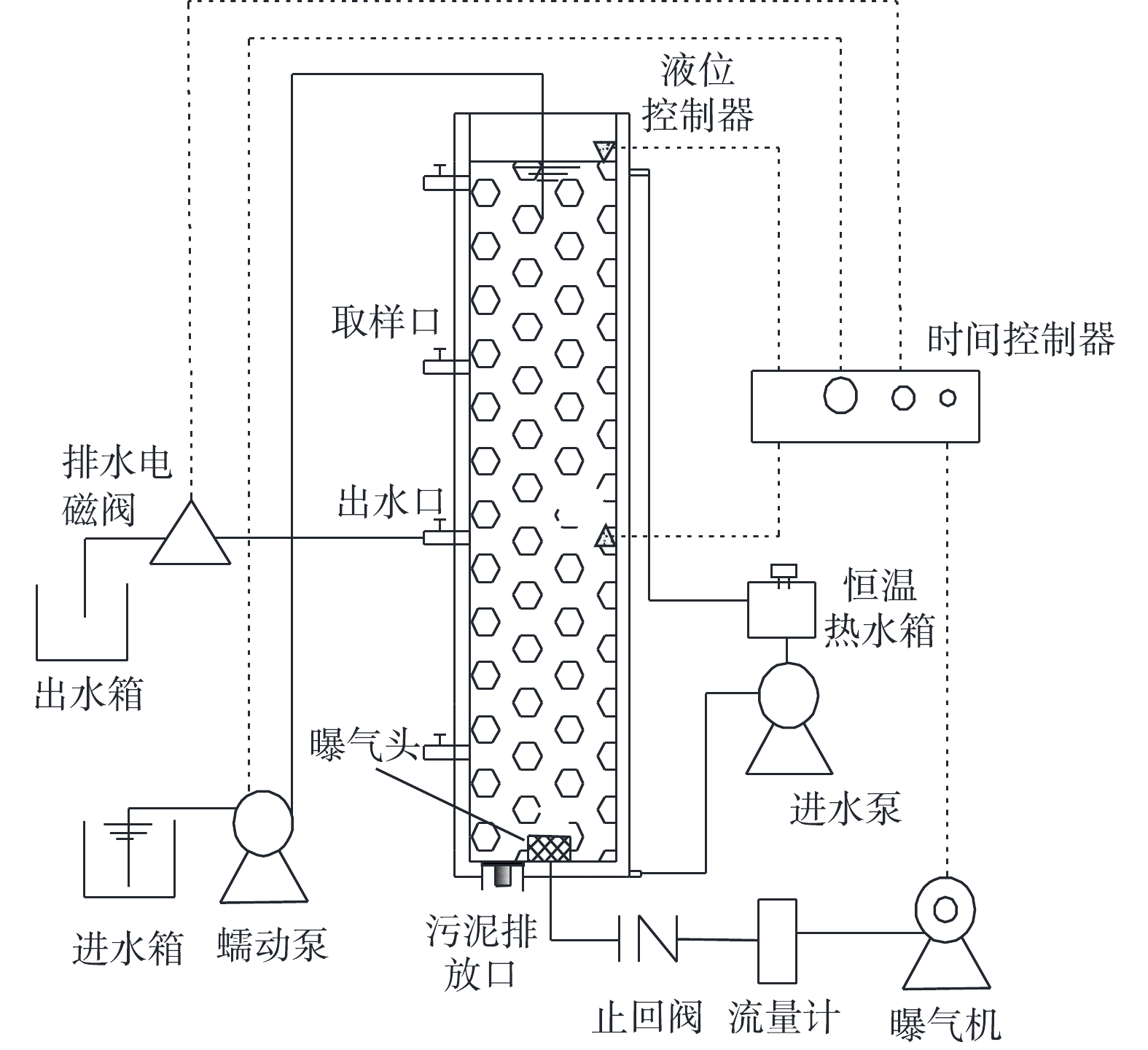

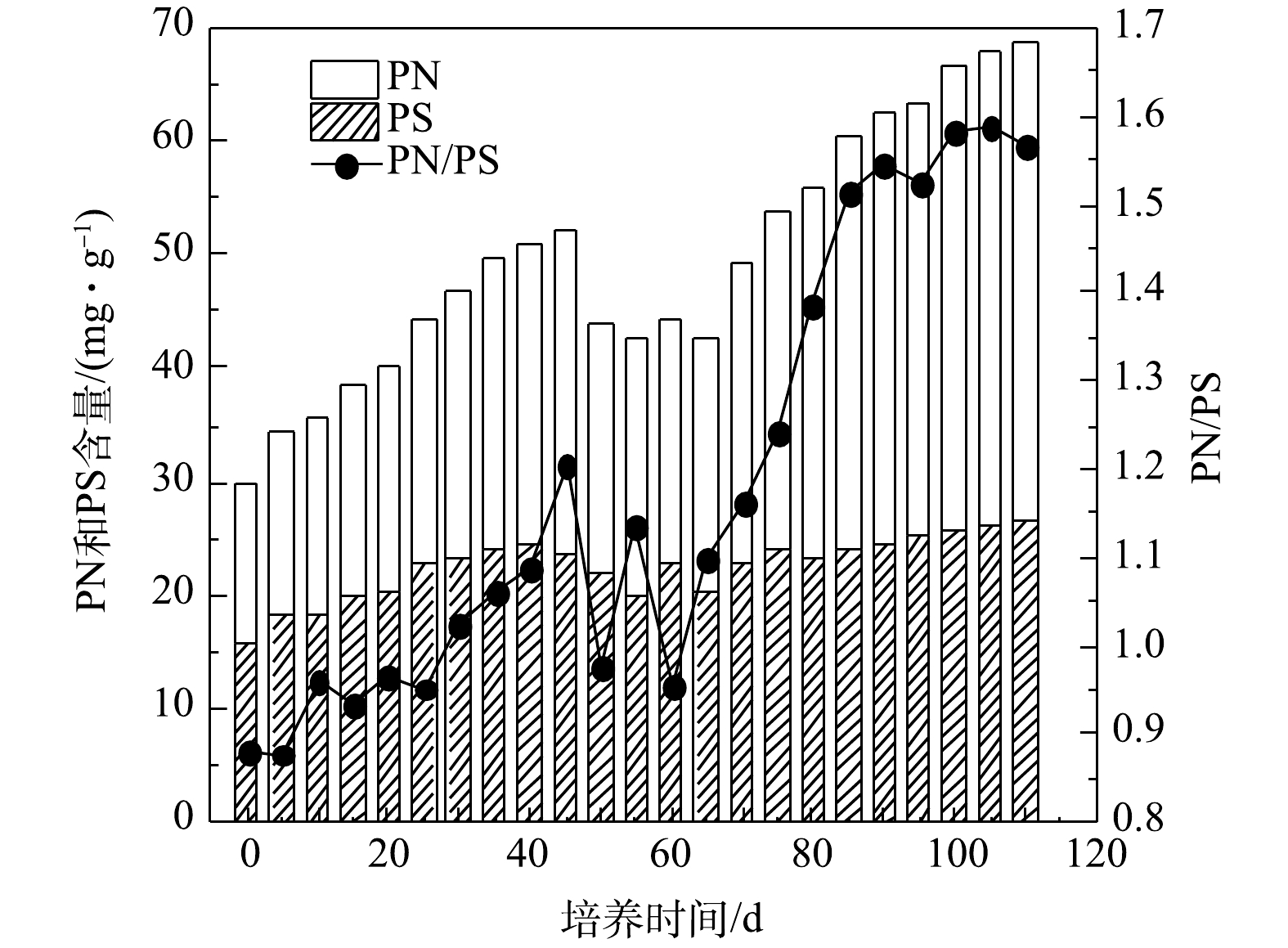
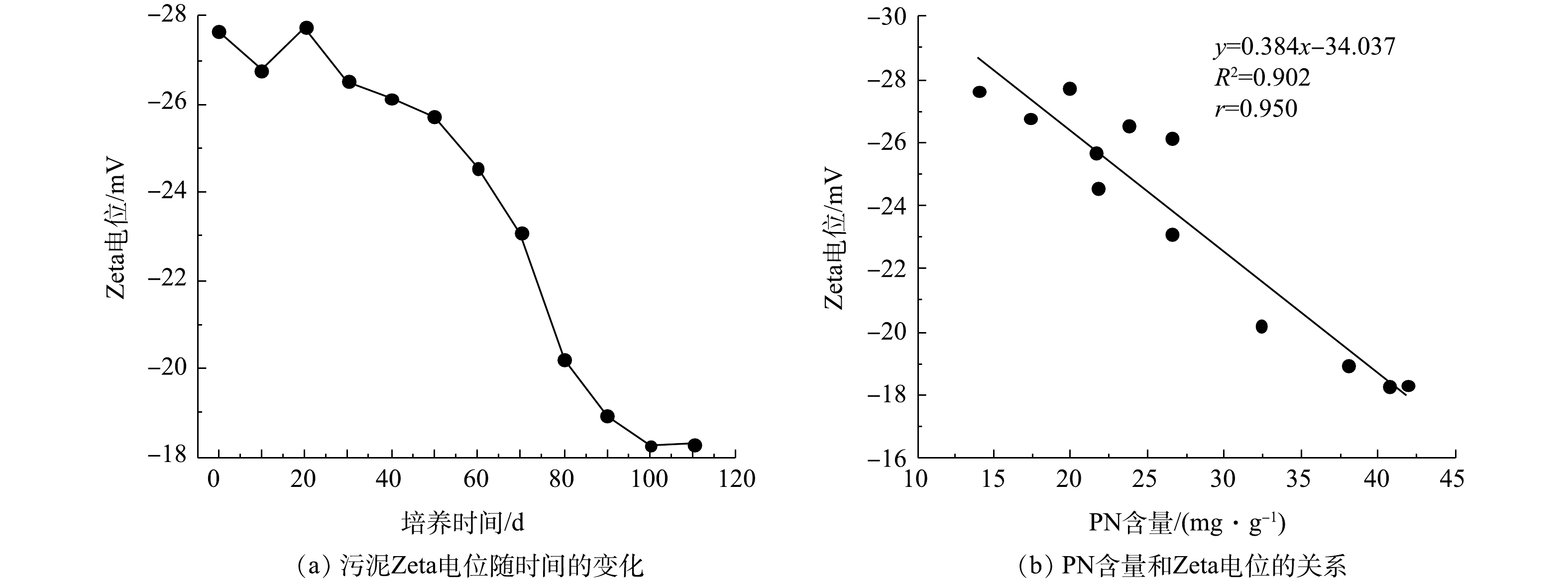
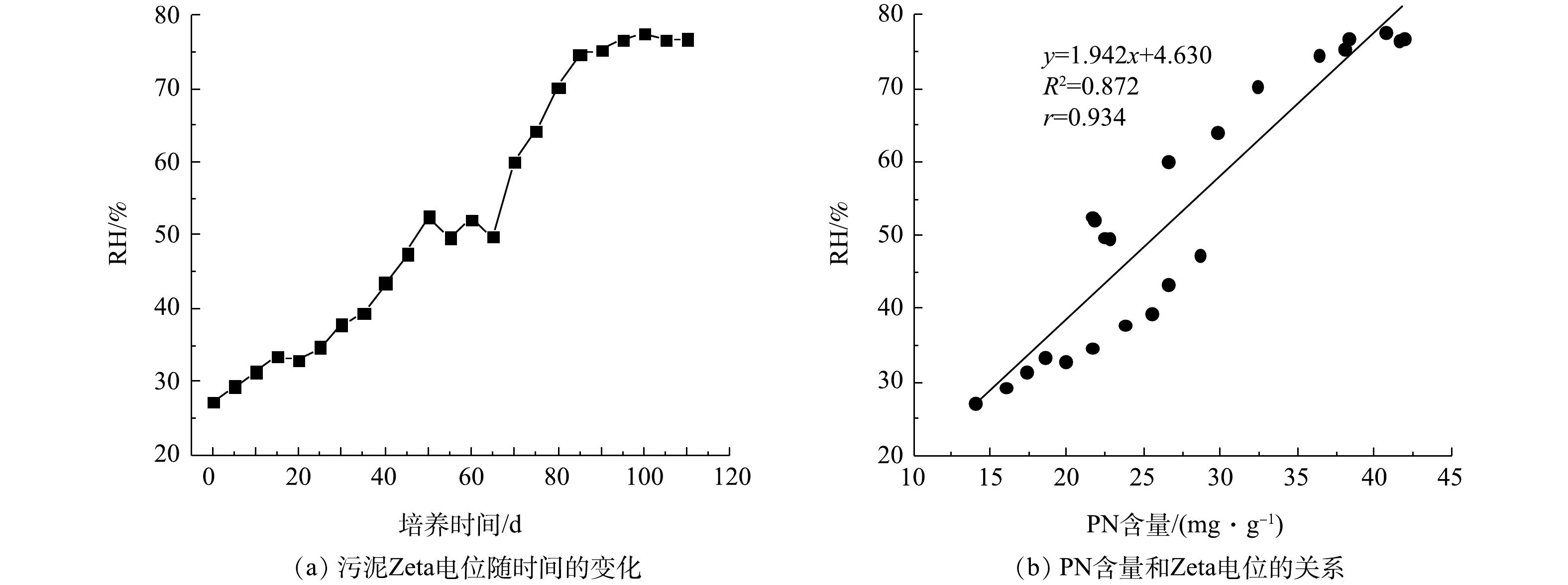



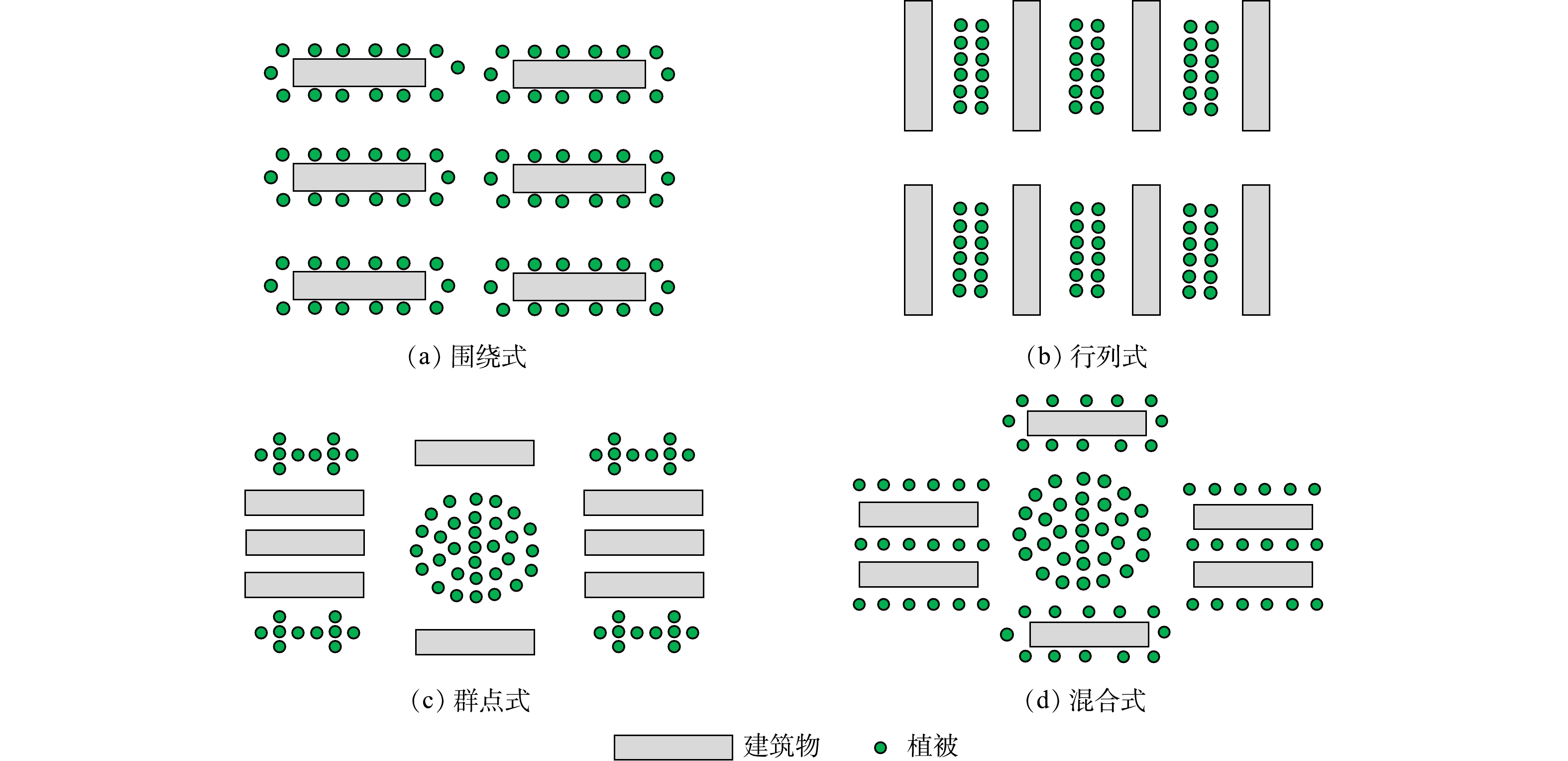
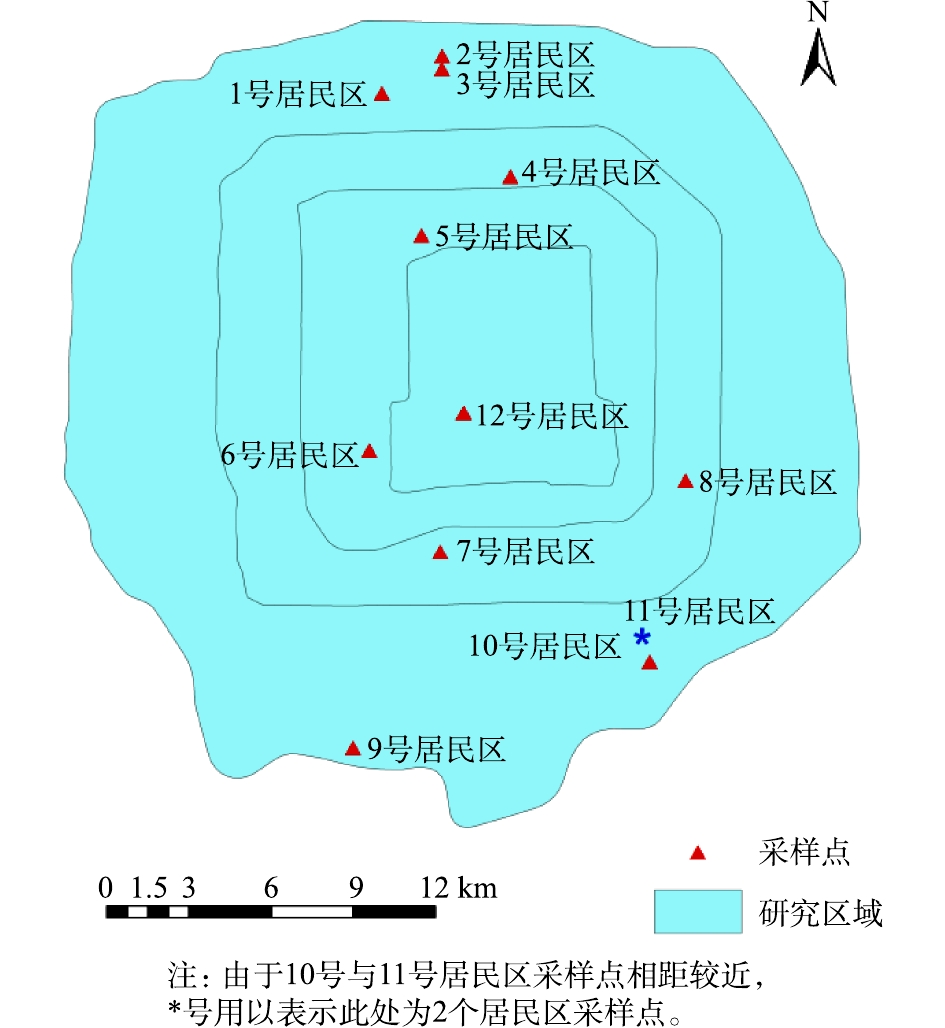
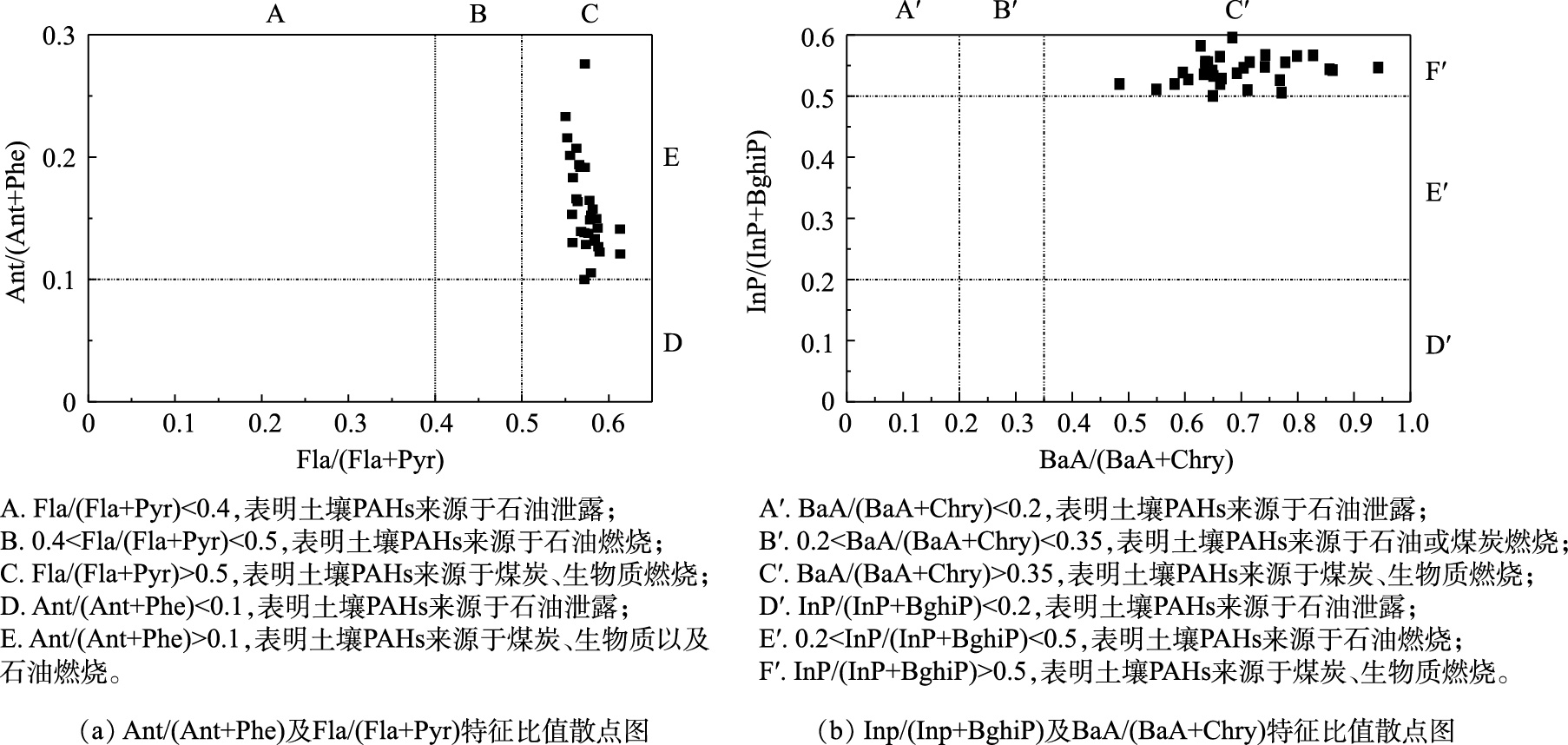
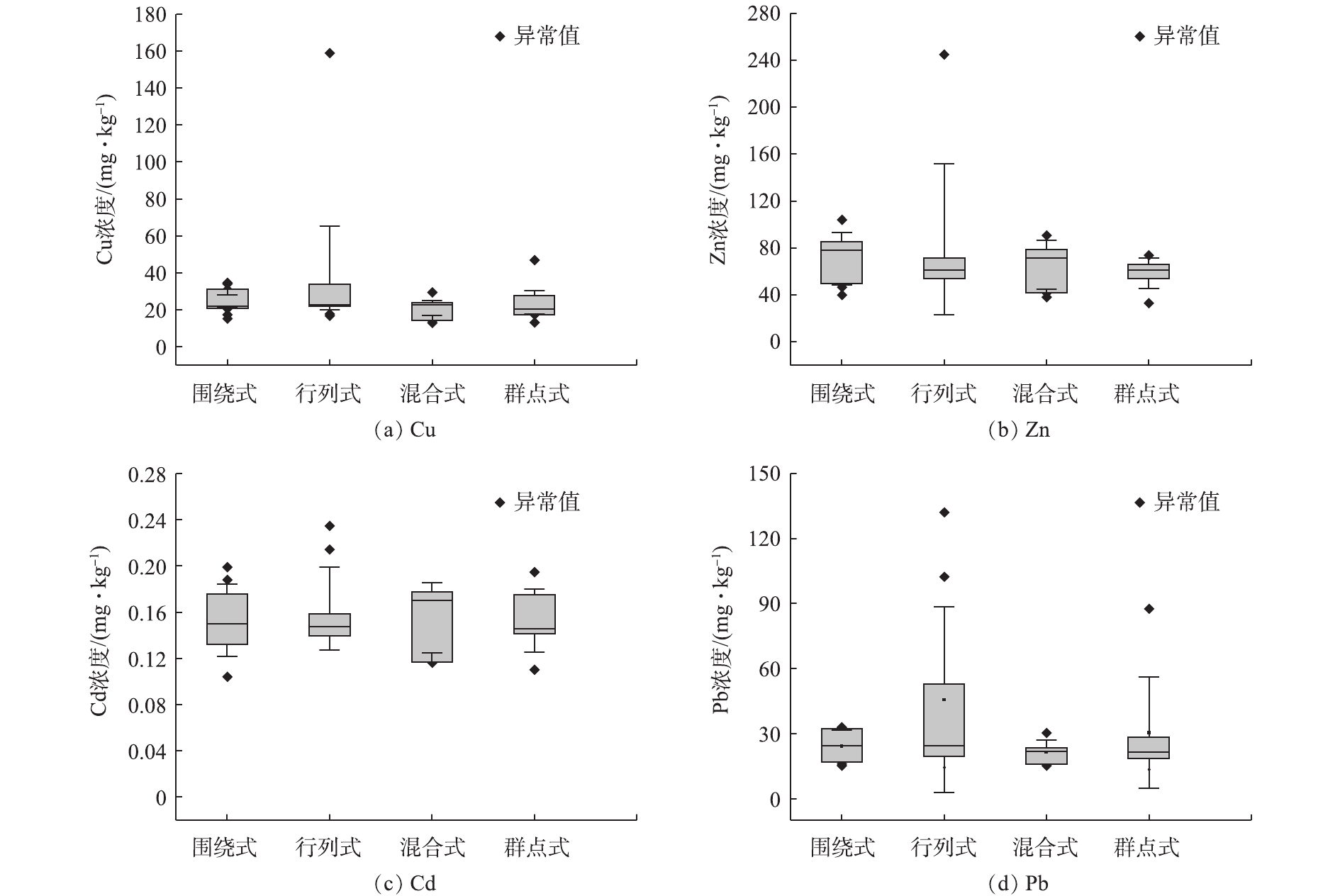


 本站查看
本站查看


